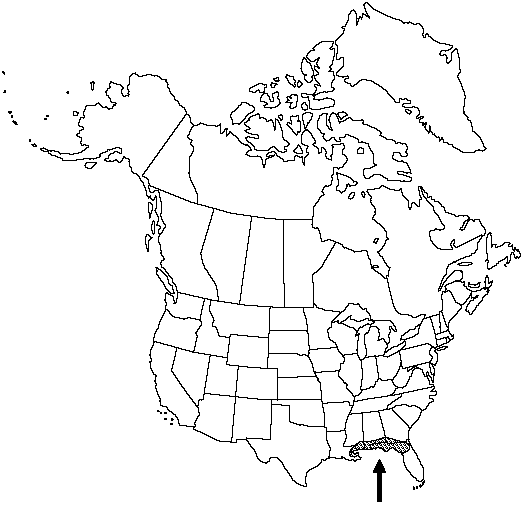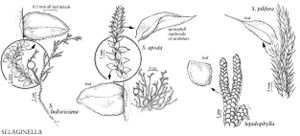Difference between revisions of "Selaginella ludoviciana"
Index Seminum (Berlin) 1857: 12. 1857-1858.
FNA>Volume Importer |
GeoffLevin (talk | contribs) (Corrected authorship and publication information for accepted name and corrected basionym) |
||
| (3 intermediate revisions by 2 users not shown) | |||
| Line 1: | Line 1: | ||
{{Treatment/ID | {{Treatment/ID | ||
|accepted_name=Selaginella ludoviciana | |accepted_name=Selaginella ludoviciana | ||
| − | |accepted_authority= | + | |accepted_authority=A. Braun |
|publications={{Treatment/Publication | |publications={{Treatment/Publication | ||
| − | |title= | + | |title=Index Seminum (Berlin) |
| − | |place= | + | |place=1857: 12. 1857-1858 |
| − | |year= | + | |year=1857-1858 |
}} | }} | ||
|common_names=Gulf spike-moss;Louisiana spike-moss | |common_names=Gulf spike-moss;Louisiana spike-moss | ||
| + | |special_status={{Treatment/ID/Special_status | ||
| + | |code=F | ||
| + | |label=Illustrated | ||
| + | }}{{Treatment/ID/Special_status | ||
| + | |code=E | ||
| + | |label=Endemic | ||
| + | }} | ||
|basionyms={{Treatment/ID/Basionym | |basionyms={{Treatment/ID/Basionym | ||
| − | |name= | + | |name=Selaginella apus var. denticulata |
| − | |authority= | + | |authority=Spring |
| − | |rank= | + | |rank=variety |
| − | |publication_title= | + | |publication_title=Mém. Acad. Roy. Sci. Belgique |
| − | |publication_place= | + | |publication_place=24: 77. 1849, not S. denticulata (L.) Spring, 1838 |
}} | }} | ||
|synonyms={{Treatment/ID/Synonym | |synonyms={{Treatment/ID/Synonym | ||
| Line 42: | Line 49: | ||
-->{{#Taxon: | -->{{#Taxon: | ||
name=Selaginella ludoviciana | name=Selaginella ludoviciana | ||
| − | |authority= | + | |authority=A. Braun |
|rank=species | |rank=species | ||
|parent rank=subgenus | |parent rank=subgenus | ||
|synonyms=Diplostachyum ludovicianum | |synonyms=Diplostachyum ludovicianum | ||
| − | |basionyms= | + | |basionyms=Selaginella apus var. denticulata |
|family=Selaginellaceae | |family=Selaginellaceae | ||
|habitat=Swamps, stream banks, ditch banks, or moist ravines of calcareous ledges | |habitat=Swamps, stream banks, ditch banks, or moist ravines of calcareous ledges | ||
| Line 52: | Line 59: | ||
|distribution=Ala.;Fla.;Ga.;La.;Miss. | |distribution=Ala.;Fla.;Ga.;La.;Miss. | ||
|reference=None | |reference=None | ||
| − | |publication title= | + | |publication title=Index Seminum (Berlin) |
| − | |publication year= | + | |publication year=1857-1858 |
| − | |special status= | + | |special status=Illustrated;Endemic |
| − | |source xml=https:// | + | |source xml=https://bitbucket.org/aafc-mbb/fna-data-curation/src/2e0870ddd59836b60bcf96646a41e87ea5a5943a/coarse_grained_fna_xml/V2/V2_259.xml |
|genus=Selaginella | |genus=Selaginella | ||
|subgenus=Selaginella subg. Stachygynandrum | |subgenus=Selaginella subg. Stachygynandrum | ||
Latest revision as of 10:24, 11 June 2023
Plants terrestrial, forming diffuse mats. Stems long-creeping, usually ascending, sparsely branched, branches mostly simple or 1-forked, flat, not articulate, glabrous. Rhizophores axillary, 0.1–0.2 mm diam. Leaves delicate, papery. Lateral leaves well spaced, green, ovate to ovate-lanceolate, 1.6–2.65 × 0.98–1.64 mm; base slightly cordate; margins transparent, serrate; apex acute to slightly obtuse, conspicuously ending in teeth. Median leaves spaced, ovate-lanceolate to narrowly ovate-lanceolate (on basal stems), 1.3–2 × 0.4–0.8 mm; base oblique on inner side, rounded and prominent on outer side; margins transparent, serrate; apex long-acuminate to bristled. Strobili solitary or paired, lax, flattened, 0.4–0.7(–1.5) cm; sporophylls very strongly keeled, keel dentate, base slightly cordate to rounded, margins transparent, sparsely serrate, apex acuminate; megasporophylls larger and wider than microsporophylls, usually on underside of strobili.
Habitat: Swamps, stream banks, ditch banks, or moist ravines of calcareous ledges
Elevation: 0–50 m
Distribution

Ala., Fla., Ga., La., Miss.
Discussion
Among the species in the flora, Selaginella ludoviciana is most closely related to S. apoda (see discussion) and has often been included in S. apoda. W. R. Buck and T. W. Lucansky (1976) concluded that two species should be recognized based on anatomic and morphologic data. A close examination of distribution of sporangia in the strobili in many specimens reveals that sporangial arrangement may be more variable than reported by H. T. Horner Jr. and H. J. Arnott (1963). All species in the S. apoda complex (see S. apoda and S. eclipes for discussion on the complex) have sporophylls with fused blade tissue.
Selected References
None.
Lower Taxa
"1857-1858" contains a sequence that could not be interpreted against an available match matrix for date components.
